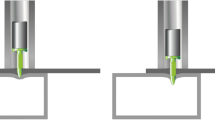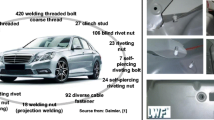Abstract
The affordable implementation of lightweight constructions in automotive engineering depends not only on the availability of suitable processing technologies for new lightweight materials but also on suitable, cost-efficient joining methods for multi-material combinations with high process reliability. Therefore, joining technology plays a key role in realizing energy-efficient vehicles. The systematic development of joining methods is necessary to overcome the metallurgical and thermal incompatibility of steel/aluminium or steel/fibre-reinforced plastic combinations. This paper presents two innovative and highly productive joining technologies and characterizes these processes based on their technological properties for one specific steel/aluminium material combination.















Similar content being viewed by others
References
European Parliament and Council (2009) Setting emission performance standards for new passenger cars as part of the Community’s integrated approach to reduce CO2 emissions from light-duty vehicles. Regulation (EC) No 443/2009 of the European Parliament and of the Council. Official Journal of the European Union, 5th June 2009
Friedrich H, Treffinger P, Kopp G, Knäbel H (2008) Werkstoffe und Bauweisen ermöglichen neue Fahrzeugkonzepte (Materials and construction methods enable new vehicle concepts). In: Schindler V, Sievers I (eds) Forschung für das Auto von Morgen. Springer, Berlin, pp 301–347 (in German)
Maas J, Staudinger W (2008) Tailored blanks in der Warmumformung (Tailored blanks in hot forming processes). ThyssenKrupp techforum 1:29–31 (in German)
Kneiphoff U, Brüggenbrock M, Hammer B, Ohse P, Quandt J, Rösen H, Stammler S (2009) Längsträger in Profil- und Schalenbauweise (Longitudinal menbers in tubular and stamped/welded designs). ATZ Extra: Das InCar-Projekt von ThyssenKrupp, issue Nov./2009, p. 40–54 (in German)
Goede M, Ferkel H, Stieg J, Dröder K (2005) Innovationen durch bezahlbaren Leichtbau (Innovation by affordable lightweight-construction), Proceedings of the 14th Colloquium of Aachen Fahrzeug- und Motorentechnik, 4th–6th October 2005, Aachen (in German)
Stahlmann A (2012) Herausforderungen des Leichtbaus für Fertigungsprozesse der Großserie (Challenges of lightweight design for high-volume manufacturing processes). Proceedings of the 5th Symposium Faszination Karosserie und Fahrzeugkonzepte, 13th/14th March 2012, Wolfsburg (in German)
Meschut G, Hahn O, Olfermann T (2012) Joining technologies for multi-material design—a key to efficient future mobility. Proceedings of the Symposium Materialien des Karosseriebaus 2012, Automotive Circle International/Vincentz Network Hannover, 11th May 2012, Bad Nauheim
Mazda (2005) Mazda develops world’s first steel and aluminium joining technology using friction heat. Press release, source: http://www.mazda.com/publicity/release/2005/200506/050602.html, 2005
Meschut G, Olfermann T, Janzen V, Matzke M (2013) Vergleich innovativer thermischer Fügeverfahren zum Verbinden von ultrahöchstfesten Stählen in Mischbaustrukturen. (Comparison of thermal based technologies for joining UHSS in multi-material-structures). Proceedings of DVS Congress, Issue 296, DVS Media GmbH, Düsseldorf, 2013. ISBN 978-3-87155-614-2 (in German)
Criqui B (2009) Robust joining processes for series production today and tomorrow. Proceedings of the International Conference on Innovative Developments for Lightweight Vehicle Structures, 26th/27th May 2009, Wolfsburg
Schulze V, Becke C, Weidenmann K, Dietrich S (2011) Machining strategies for hole making in composites with minimal workpiece damage by directing the process forces inwards. J Mater Process Technol 211(3):329–338
Engbert T, Kempmann C, Zabel A (2007) Qualitätsgerechte Bohrungsfertigung: Bearbeitung von Leichtbauwerkstoffen durch Zirkularfräsen (Quality-oriented drilling: Machining of lightweight materials by circular milling). Journal: Intelligenter Produzieren - Leichtbau - Herausforderungen für die moderne Produktionstechnik, VDMA Verlag, Issue 3, 2007, p. 22–23 (in German)
Hahn O, Meschut G, Janzen V, Flüggen F (2012) Weiterentwicklung des Schweißnietens für die Anbindung von Leichtbaumetallen und faserverstärkten Kunststoffen an Stahlstrukturen (Development of resistance element welding for joining lightweight-constructions). Public AIF funded research project no. P862, Forschungsvereinigung Stahlanwendung e.V., Düsseldorf, 2010–2012 (in German)
Baron T (2010) Entwicklung des Reibelementschweißens für den Einsatz im Karosserierohbau (Development of the friction element welding for the use in car body manufacturing). PhD Thesis, Faculty of Mechanical Engineering, University of Paderborn, 2010 (in German)
Hahn O, Meschut G, Olfermann T, Süllentrop S, Janzen V (2013) Fügeverfahren in hybriden Leichtbaustrukturen (Joining technologies for hybrid multi-material structures). In: Friedrich H (ed) Leichtbau der Fahrzeugtechnik. Springer Vieweg, Wiesbaden (in German)
Alber U (2012) Friction element welding—innovations for hybrid body parts. Proceedings of the Symposium Fügen im Karosseriebau 2012, Automotive Circle International/Vincentz Network Hannover, 18th/19th September, 2012, Bad Nauheim
Amedick J, Borowetz H, Heyn H (2011) Fügetechnologien im Wettbewerb—Anforderungen der Automobilindustrie (Joining technologies in competition - requirements of the automotive industry). Proceedings of the Colloquium Gemeinsame Forschung in der mechanischen Fügetechnik, EFB e.V., 6th/7th December 2011, Garbsen, p. 11–23, 2011 (in German)
DVS/EFB 3480-1 (2007) Prüfung von Verbindungseigenschaften - Prüfung der mechanisch kombiniert mittels Kleben gefertigter Verbindungen (Evaluation of joining properties). Instruction sheet of DVS/EFB-Committee “Mechanisches Fügen”, DVS Media, Düsseldorf, 2007 (in German)
Briskham P, Blundell N, Han l, Hewitt R, Young K, Boomer D (2006) Comparison of self-pierce riveting, resistance spot welding and spot friction joining for aluminium automotive sheet. SAE Technical Paper 2006-01-0774, SAE 2006, World Congress & Exhibition, Detroit
Hahn O, Meschut G, Bednorz S, Schübeler S (2012) Stanznieten hochfester Stähle mit NE-Hochleistungswerkstoffen (Self-pierce riveting of UHSS with non-metal high-performance materials). Proceedings of the 32. EFB Kolloquium Blechverarbeitung - Produktionssysteme und Methoden für den Leichtbau, 14th/15th February 2012, p. 163–178, Bad Boll, 2012 (in German)
Acknowledgments
In this paper, selected results of the funded research projects P862 (IGF 16.806 N) were presented. The IGF project 16806 N (P 862) of the research association Forschungsvereinigung Stahlanwendung e.V. - FOSTA, Sohnstrasse 65, 40237 Düsseldorf was funded by the AiF under the programme for the promotion of joint industrial research and development (IGF) by the Federal Ministry of Economics and Technology based on a decision of the German Bundestag. We also thank the members of the project support committee for their organizational and financial support.
Author information
Authors and Affiliations
Corresponding author
Additional information
Doc. IIW-2414, recommended for publication by SC-Auto “Select Committee Automotive and Road Transport.”
Rights and permissions
About this article
Cite this article
Meschut, G., Hahn, O., Janzen, V. et al. Innovative joining technologies for multi-material structures. Weld World 58, 65–75 (2014). https://doi.org/10.1007/s40194-013-0098-3
Received:
Accepted:
Published:
Issue Date:
DOI: https://doi.org/10.1007/s40194-013-0098-3




